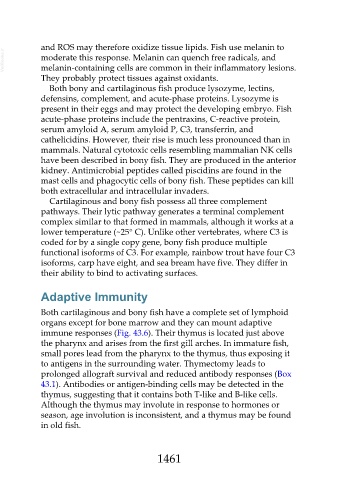Page 1461 - Veterinary Immunology, 10th Edition
P. 1461
and ROS may therefore oxidize tissue lipids. Fish use melanin to
VetBooks.ir moderate this response. Melanin can quench free radicals, and
melanin-containing cells are common in their inflammatory lesions.
They probably protect tissues against oxidants.
Both bony and cartilaginous fish produce lysozyme, lectins,
defensins, complement, and acute-phase proteins. Lysozyme is
present in their eggs and may protect the developing embryo. Fish
acute-phase proteins include the pentraxins, C-reactive protein,
serum amyloid A, serum amyloid P, C3, transferrin, and
cathelicidins. However, their rise is much less pronounced than in
mammals. Natural cytotoxic cells resembling mammalian NK cells
have been described in bony fish. They are produced in the anterior
kidney. Antimicrobial peptides called piscidins are found in the
mast cells and phagocytic cells of bony fish. These peptides can kill
both extracellular and intracellular invaders.
Cartilaginous and bony fish possess all three complement
pathways. Their lytic pathway generates a terminal complement
complex similar to that formed in mammals, although it works at a
lower temperature (~25° C). Unlike other vertebrates, where C3 is
coded for by a single copy gene, bony fish produce multiple
functional isoforms of C3. For example, rainbow trout have four C3
isoforms, carp have eight, and sea bream have five. They differ in
their ability to bind to activating surfaces.
Adaptive Immunity
Both cartilaginous and bony fish have a complete set of lymphoid
organs except for bone marrow and they can mount adaptive
immune responses (Fig. 43.6). Their thymus is located just above
the pharynx and arises from the first gill arches. In immature fish,
small pores lead from the pharynx to the thymus, thus exposing it
to antigens in the surrounding water. Thymectomy leads to
prolonged allograft survival and reduced antibody responses (Box
43.1). Antibodies or antigen-binding cells may be detected in the
thymus, suggesting that it contains both T-like and B-like cells.
Although the thymus may involute in response to hormones or
season, age involution is inconsistent, and a thymus may be found
in old fish.
1461

